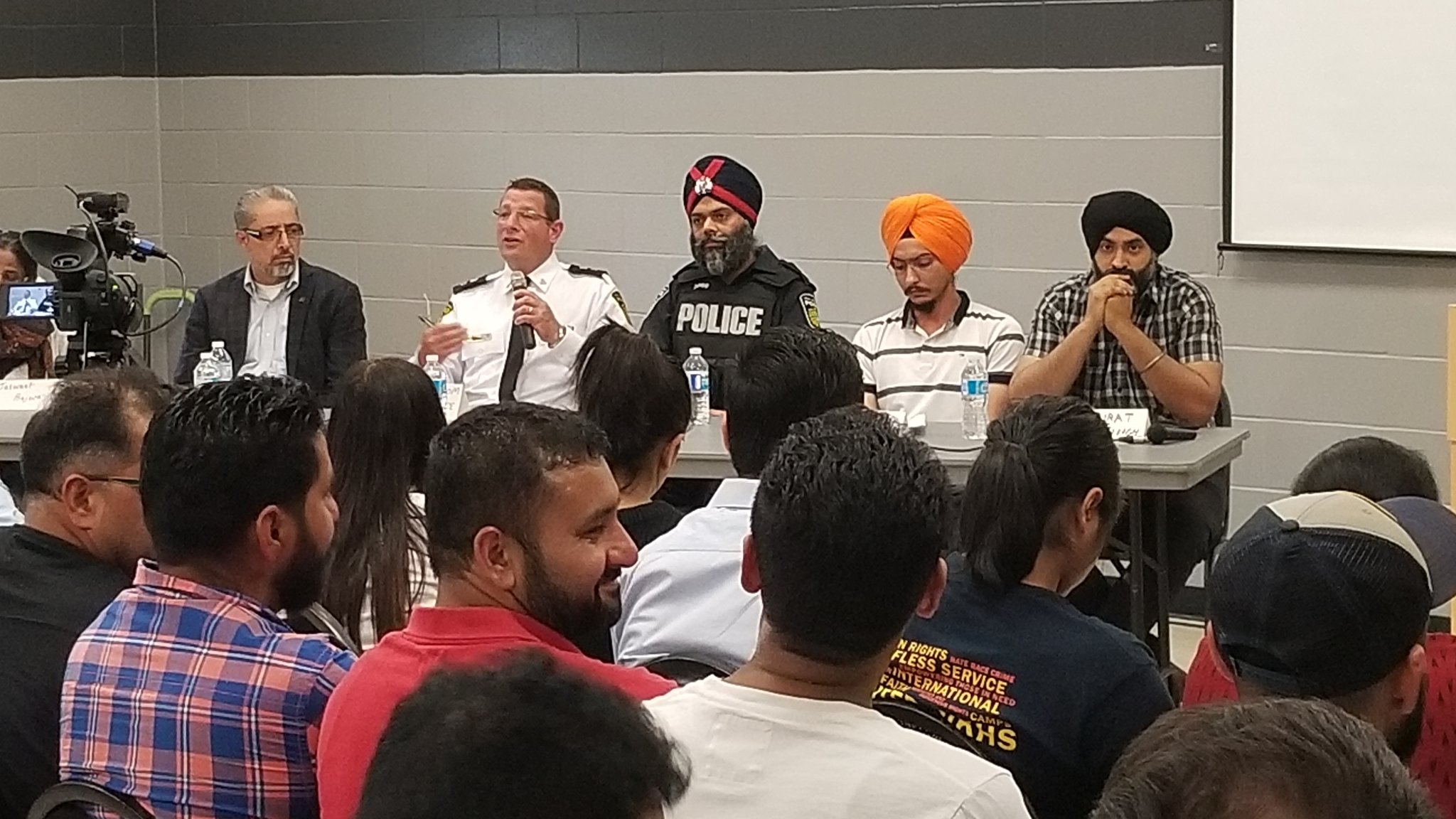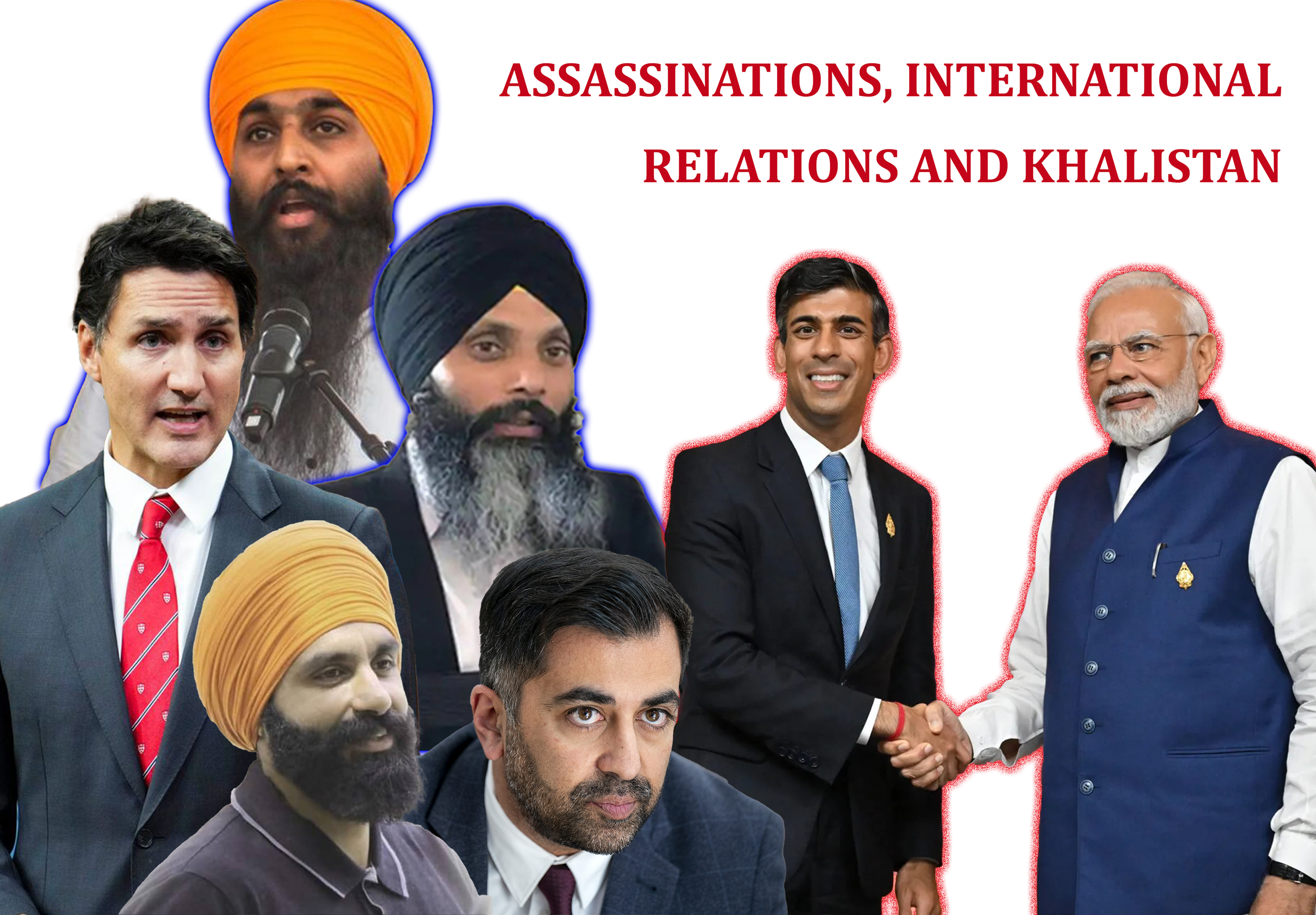ਨਾਨਕ ਪਰਖੇ ਅਾਪ ਕੳੁ ਤਾ ਪਾਰਖੁ ਜਾਣੁ ॥ ਰੋਗੁ ਦਾਰੂ ਦੋਵੈ ਬੁਝੈ ਤਾ ਵੈਦੁ ਸੁਜਾਣੁ ॥
/ਬੜੀ ਵੇਰ ਘਟਨਾਵਾਂ ਦੀ ਉਡਾਈ ਗਰਦ ਸਾਨੂੰ ਉਸਦੇ ਕਾਰਨਾਂ ਤੱਕ ਨਹੀਂ ਪਹੁੰਚਣ ਦਿੰਦੀ। ਅਸੀਂ ਜੜ੍ਹ ਤੱਕ ਪਹੁੰਚਣ ਦੀ ਵਜਾਏ ਘਟਨਾ ਉੱਤੇ ਹੀ ਐਨਾ ਕੇਂਦਰਿਤ ਹੋ ਜਾਂਦੇ ਹਾਂ ਕਿ ਅਸਲ ਕਾਰਨ ਸਮਝ ਨਹੀਂ ਪੈਂਦੇ। ਘਟਨਾਵਾਂ ਭਾਂਵੇ ਨਿੱਜੀ ਬੰਦਿਆਂ ਅਤੇ ਨਿੱਜੀ ਮਸਲਿਆਂ ਤੱਕ ਸੀਮਤ ਲਗਦੀਆਂ ਹਨ ਪਰ ਕਈ ਵੇਰ ਇਸਨੂੰ ਡੂੰਘਾਈ ਨਾਲ਼ ਸਮਝਣ ਲਈ ਕੌਮ ਦੀ ਸਮੂਹਿਕ ਦਸ਼ਾ ਦਾ ਅਧਿਐਨ ਕਰਨਾ ਜ਼ਰੂਰੀ ਹੈ।
ਅਫ਼ਰੀਕਨ ਲੋਕਾਂ ਨੇ ਬਹੁਤ ਭੈੜੀ ਗ਼ੁਲਾਮੀ ਹੰਢਾਈ ਹੈ, ਇਸਦਾ ਅਸਰ ਉਨ੍ਹਾਂ ਦੀ ਮਾਨਸਿਕਤਾ ਉੱਤੇ ਅੱਜ ਤੱਕ ਹੈ। ਦੂਜਾ ਸਰਕਾਰਾਂ ਨੇ ਮਿਥ ਕੇ ਉਨ੍ਹਾਂ ਵਿੱਚ ਨਸ਼ੇ ਦਾ ਪਸਾਰਾ ਕੀਤਾ ਹੈ ਤਾਂ ਕਿ ਉਨ੍ਹਾਂ ਦੇ ਨੌਜਵਾਨ ਆਪਣੇ ਹੱਕਾਂ, ਭਵਿੱਖ ਅਤੇ ਆਲ਼ੇ-ਦੁਆਲ਼ੇ ਵਾਰੇ ਫ਼ਿਕਰ ਕਰਨਯੋਗ ਨਾ ਰਹਿਣ।
ਅਗਰ ਆਪਾਂ ਕਿਸੇ ਅਫ਼ਰੀਕਨ ਨਾਲ਼ ਥੋੜੀ ਭਾਰੂ (aggressive) ਹੋ ਕੇ ਗੱਲ ਕਰੀਏ ਤਾਂ ਉਹ ਅਚਾਨਕ ਆਪਣੇ ਬਚਾਅ 'ਚ ਆ ਜਾਂਦੇ ਹਨ ਅਤੇ ਲੜਨ ਲਈ ਤਿਆਰ ਰਹਿੰਦੇ ਹਨ। ਲੜ੍ਹਾਈ ਦਾ ਕਾਰਨ ਭਾਂਵੇ ਸਮੇਂ ਜਾਂ ਹਲਾਤ ਨਾਲ਼ ਕੋਈ ਹੋਰ ਬਣੇ ਪਰ ਐਨੇ ਸਾਲ਼ਾ ਦੀ ਗ਼ੁਲਾਮੀ ਅਤੇ ਮਿਥ ਕੇ ਹੋਏ ਸਰੀਰਕ ਅਤੇ ਮਾਨਸਿਕ ਸ਼ੋਸ਼ਣ ਦਾ ਜੋ ਉਸਦੀ ਮਾਨਸਿਕਤਾ ਉੱਤੇ ਅਸਰ ਹੋਇਆ ਹੈ, ਉਸਨੂੰ ਅੱਖੋਂ ਪਰੋਖੇ ਨਹੀਂ ਕੀਤਾ ਜਾ ਸਕਦਾ।
ਕੱਲ੍ਹ ਮੈਂ ਪੰਜਾਬ ਦੇ ਨੌਜਵਾਨਾਂ ਦੀ ਮਾਨਸਿਕ ਦਸ਼ਾ ਦੀ ਗੱਲ ਕੀਤੀ ਤਾਂ ਲੋਕਾਂ ਇਸਦਾ ਮਜ਼ਾਕ ਬਣਾ ਲਿਆ, ਖ਼ੈਰ ਮੈਨੂੰ ਪੂਰੀ ਆਸ ਸੀ ਕਿ ਇਹ ਗੱਲ ਇੰਨੀ ਕੁ ਹੀ ਸਮਝ ਆਵੇਗੀ। ਜੇ ਸਾਡੇ ਲੋਕ ਐਨਾ ਸਮਝਦੇ ਹੁੰਦੇ ਤਾਂ ਮੌਜਾਦਾ ਹਲਾਤਾਂ ਪ੍ਰਤੀ ਅੱਜ ਸਾਡਾ ਸੰਵਾਦ ਅਤੇ ਰਵੱਇਆ ਹੋਰ ਕਿਸਮ ਦਾ ਹੁੰਦਾ।
ਕਨੇਡਾ ਵਿੱਚ ਬਹੁਗਿਣਤੀ ਪੰਜਾਬੀ ਵਿਦਿਆਰਥੀ ਸਿੱਖ ਘਰਾਂ 'ਚੋਂ ਆਉਂਦੇ ਹਨ। ਇਹ ਸਭ ਚੌਰਾਸੀ ਤੋਂ ਅਤੇ ਖਾੜਕੂ ਲਹਿਰ ਤੋਂ ਬਾਅਦ ਜਨਮੇ ਹਨ। ਇਸ ਲਹਿਰ ਤੋਂ ਬਾਅਦ ਜੋ ਸਰਕਾਰਾਂ ਨੇ ਮਿਥ ਕੇ ਵਿਦਿਆ ਅਤੇ ਮੀਡੀਏ ਰਾਹੀਂ ਪੰਜਾਬ ਦਾ ਮਾਹੌਲ ਸਿਰਜਿਆ, ਜਿਸਦਾ ਮਕਸਦ ਪੰਜਾਬ ਦੇ ਨੌਜਵਾਨਾਂ ਨੂੰ ਆਪਣੇ ਹੱਕਾਂ, ਭਵਿੱਖ ਅਤੇ ਇਤਿਹਾਸਕ ਨਾਇਕਾਂ ਤੋਂ ਦੂਰ ਕਰਕੇ ਨਵੇੰ ਕਿਸਮ ਦੇ ਝੂਠੇ ਨਾਇਕ ਸਿਰਜਣਾ ਸੀ। ਜਿਸ ਨਾਲ਼ ਕਿ ਨੌਜਵਾਨ ਨਿੱਜੀ ਐਸ਼ਪ੍ਰਸਤੀ ਵੱਲ ਧੱਕੇ ਜਾਣ ਅਤੇ ਸਰਕਾਰਾ ਦੇ ਚੱਲ ਰਹੇ ਝੂਠੇ-ਪੱਕੇ ਏਜੰਡੇ ਜਾਂ ਮਿਸ਼ਨ ਨੂੰ ਚੁਣੌਤੀ ਨਾ ਦੇਣ। ਇਹ ਨੌਜਵਾਨ ਉਸੇ ਮਾਹੌਲ ਦੀ ਪਦਾਇਸ਼ ਅਤੇ ਸ਼ਿਕਾਰ ਹਨ। ਹੋਰ ਮਾਨਸਿਕ ਪ੍ਰਭਾਵ ਤੋਂ ਇਹ ਮਤਲਬ ਨਹੀਂ ਕਿ ਨੌਜਵਾਨ ਪਾਗਲ ਹਨ।
ਇਸ ਤਰ੍ਹਾਂ ਦੀਆਂ ਟਿੱਚਰਾਂ ਕਰਨ ਵਾਲ਼ੇ ਸ਼ਾਇਦ ਭੁੱਲਦੇ ਹਨ ਕਿ ਇਨ੍ਹਾਂ ਦੀ ਮਾਨਸਿਕਤਾ ਵੀ ਪ੍ਰਭਾਵਤ ਹੈ। ਕਿਉਂਕਿ ਮੌਜੂਦਾ ਗੀਤ ਸੰਗੀਤ ਅਤੇ ਨਸ਼ਿਆਂ ਦੀ ਤਰਜ਼ ਉੱਤੇ ਪੰਜਾਬ ਦੀ ਸਿੱਖ ਨੌਜਵਾਨੀ ਨੂੰ ਰੋਲ਼ਣ ਦਾ ਕਾਰਜ ਤੀਬਰਤਾ ਨਾਲ਼ ਦੋ ਦਹਾਕੇ ਪਹਿਲੋਂ ਹੀ ਸ਼ੁਰੂ ਹੋਇਆ, ਇਸ ਕਰਕੇ ਪਹਿਲੋਂ ਜੰਮੇ ਜਾਂ ਜਿਨ੍ਹਾਂ ਚੌਰਾਸੀ ਜਾਂ ਖਾੜਕੂ ਲਹਿਰ ਵੇਖੀ, ਉਨ੍ਹਾਂ ਉੱਤੇ ਮਾਨਸਿਕ ਅਸਰ ਹੋਰ ਕਿਸਮ ਦੇ ਹਨ, ਸੰਤਾਲ਼ੀ ਦੀ ਵੰਡ ਵੇਖਣ ਵਾਲ਼ਿਆਂ ਉੱਤੇ ਹੋਰ ਕਿਸਮ ਦੇ ਹੋਣਗੇ। ਕੋਈ ਵੀ ਵੱਡੀ ਘਟਨਾ ਵੱਖ-ਵੱਖ ਕੌਮਾਂ ਉੱਤੇ ਵੱਖ-ਵੱਖ ਕਿਸਮ ਦਾ ਪ੍ਰਭਾਵ ਛੱਡਦੀ ਹੈ।
ਸਮੂਹਿਕ ਰੂਪ ਵਿੱਚ ਸਾਡੀ ਕੌਮ ਸਾਰੀ ਦੁਨੀਆ ਵਿੱਚ ਇੱਕ ਡਰ ਵਿੱਚ ਜਿਉਂ ਰਹੀ ਹੈ। ਸਾਨੂੰ ਪੈਰ ਪੈਰ ਉੱਤੇ ਆਪਣੀ ਚੰਗਿਆਈ ਸਾਬਤ ਕਰਨ ਦਾ ਭੁਸ ਪੈ ਗਿਆ ਹੈ ਕਿਉਂਕਿ ਅਸੀਂ ਅੰਦਰੋਂ ਡਰੇ (insecure) ਹਾਂ। ਕਿਤੇ ਕੋਈ ਘਟਨਾ ਹੋਵੇ, ਸਾਨੂੰ ਇਹ ਮਹਿਸੂਸ ਹੋਣ ਲੱਗ ਜਾਂਦਾ ਕਿ ਜੇ ਅਸੀਂ ਇਸਦੀ ਨਿੰਦਿਆ ਨਾ ਕੀਤੀ ਤਾਂ ਖੌਰੇ ਸਾਨੂੰ ਕੋਈ ਦੋਸ਼ੀ ਨਾ ਕਰਾਰ ਦੇ ਦੇਵੇ। ਭਾਰਤ ਬੈਠਿਆਂ ਨੂੰ ਡਰ ਹੁੰਦਾ ਸਾਨੂੰ ਦੇਸ਼-ਵਿਰੋਧੀ ਨਾ ਆਖ ਦੇਣ ਅਤੇ ਬਾਹਰ ਬੈਠਿਆਂ ਨੂੰ ਹੁੰਦਾ ਕਿ ਸਾਨੂੰ ਕਿਤੋਂ ਇੱਥੋਂ ਕੱਢ ਨਾ ਦੇਣ।
ਗ਼ੁਲਾਮੀ ਨੇ ਸਾਨੂੰ ਲੇਲੜੀਆਂ ਕੱਢਣ ਵਾਲ਼ੀ ਕੌਮ ਬਣਾ ਦਿੱਤੀ ਹੈ ਜਿਸਨੂੰ ਰੋਜ਼ ਹਰ ਘਟਨਾ ਉੱਤੇ ਆਪਣੀ ਨਾ-ਸਮੂਲੀਅਤ ਅਤੇ ਚੰਗੇਪਣ ਦਾ ਸਪਸ਼ਟੀਕਰਨ ਦੇਣਾ ਪੈਂਦਾ ਹੈ ਅਤੇ ਪੈਰ ਪੈਰ ਉੱਤੇ ਸਮਝੌਤਾ ਕਰਨਾ ਪੈਂਦਾ ਹੈ। ਕਨੇਡਾ ਵਿੱਚ ਹੋਈ ਨੌਜਵਾਨਾਂ ਦੀ ਹਿੰਸਾ ਤੋਂ ਬਾਅਦ ਕੌਮ ਦਾ ਪ੍ਰਤੀਕਰਮ ਇਹੋ ਡਰ ਹੈ। ਆਪਣੇ ਆਪ ਨੂੰ ਕਨੇਡੀਅਨ ਹੋਣ ਦਾ ਭਰਮ ਪਾਲ਼ੀ ਬੈਠੇ ਵੀ ਅਸਲ ਵਿੱਚ ਅਜ਼ਾਦ ਨਹੀਂ ਹਨ। ਉਨ੍ਹਾਂ ਨੂੰ ਜਾਪਦਾ ਹੈ ਕਿ ਇਨ੍ਹਾਂ ਨੌਜਵਾਨਾਂ ਕਰਕੇ ਗੋਰੇ ਸਾਨੂੰ ਗੁੰਡੇ-ਬਦਮਾਸ਼ ਨਾ ਸਮਝ ਲੈਣ, ਸਾਨੂੰ ਕਨੇਡਾ ਤੋਂ ਕੱਢ ਨਾ ਦੇਣ। ਓਥੇ ਹਿੰਦੂ ਅਤੇ ਇੱਥੇ ਗੋਰੇ, ਅਸੀਂ ਸਭ ਕੁਝ ਦੂਜਿਆਂ ਨੂੰ ਸਾਬਤ ਕਰਨ ਨੂੰ ਫਿਰਦੇ ਹਾਂ, ਸਾਡਾ ਆਤਮ-ਵਿਸ਼ਵਾਸ ਅਤੇ ਸਵੈਮਾਣ ਦੂਜਿਆਂ ਕੋਲ਼ ਗਹਿਣੇ ਹੈ।
ਰੋਜ਼ ਕਿੰਨੀਆਂ ਲੜਾਈਆਂ ਹੁੰਦੀਆਂ ਹਨ, ਕਿੰਨੇ ਗੈਂਗ ਅਤੇ ਹਥਿਆਰ ਫੜੇ ਜਾਂਦੇ ਹਨ, ਕੀ ਕਦੇ ਗੋਰੇ ਜਾਂ ਹਿੰਦੂ ਜਾਂ ਹੋਰ ਸਾਡੇ ਵਾਂਗ 'insecure' ਮਹਿਸੂਸ ਕਰਦੇ ਹਨ? ਉਹਨਾਂ ਨੂੰ ਕਦੇ ਸਪਸ਼ਟੀਕਰਨ ਨਹੀਂ ਦੇਣਾ ਪੈਂਦਾ ਪਰ ਅਸੀਂ ਜਦ ਤੱਕ ਸਪਸ਼ਟੀਕਰਨ ਨਾ ਦੇਇਏ, ਉਦੋਂ ਤੱਕ ਇੱਕ ਤਰਾਂ ਨਾਲ਼ ਦੋਸ਼ੀ ਮਹਿਸੂਸ ਕਰਦੇ ਹਨ। ਕਿਸੇ ਬੁਰੀ ਘਟਨਾ ਨੂੰ ਨਿੰਦਣਾ ਗ਼ਲਤ ਨਹੀਂ ਪਰ ਸਾਡੇ ਬਿਆਨ ਘਟਨਾ ਨੂੰ ਨਿੰਦਣ ਲਈ ਘੱਟ ਅਤੇ ਆਪਣੇ ਡਰ 'ਚੋਂ ਜ਼ਿਆਦਾ ਨਿਕਲ਼ਦੇ ਹਨ।
ਆਧੁਨਿਕ ਸਮਾਜ ਵਿੱਚ, ਜਿੱਥੇ ਸੱਭੋ ਕੁਝ ਤਟ ਫਟ ਹੁੰਦਾ ਹੈ, ਅਸੀਂ ਹਰ ਮਸਲੇ ਨੂੰ ਸਮਝਣ, ਉਸਦੇ ਉੱਤੇ ਰਾਏ ਬਣਾਉਣ ਅਤੇ ਉਸਦੇ ਹੱਲ ਲੱਭਣ ਵਿੱਚ ਵੀ 'ਤਟ ਫਟ' ਕਰਦੇ ਹਾਂ। 'Black and white' ਦੀ ਮਾਨਸਿਕਤਾ, ਜਿਸਤੋਂ ਭਾਵ ਕਿ ਚੀਜ਼ ਸਿਰਫ਼ ਗ਼ਲਤ ਜਾਂ ਸਹੀ ਹੀ ਹੈ, ਇਸਤੋਂ ਬਿਨ੍ਹਾਂ ਤੀਜਾ ਜਾਂ ਚੌਥਾ ਪੱਖ ਨਹੀਂ ਹੋ ਸਕਦਾ, ਸਾਡੇ ਉੱਤੇ ਭਾਰੂ ਹੈ। ਅਸੀਂ ਘਟਨਾਵਾਂ ਨੂੰ ਡੂੰਘਾ ਉੱਤਰ ਘੋਖਣਾ ਨਹੀਂ ਚਾਹੁੰਦੇ। ਜਦ ਤੱਕ ਸਮੱਸਿਆ ਦੇ ਕਾਰਨ ਸਪਸ਼ਟ ਨਹੀਂ ਹੁੰਦੇ, ਹੱਲ ਕਦੇ ਨਹੀਂ ਹੋਵੇਗਾ ਅਤੇ ਮੌਜੂਦਾ ਹਲਾਤਾਂ ਵਿੱਚ ਸਾਨੂੰ ਭਰਮ ਹੈ ਕਿ ਅਸੀਂ ਕਾਰਨ ਸਮਝਦੇ ਹਾਂ।
ਕਨੇਡਾ ਵਿੱਚ ਪੰਜਾਬੋਂ ਆਏ ਨੌਜਵਾਨਾਂ ਦੀ ਹਿੰਸਾ ਅਤੇ ਹਲਾਤਾਂ ਨੂੰ ਅਸੀਂ ਪੰਜਾਬ ਨਾਲ਼ੋਂ ਵੱਖ ਕਰਕੇ ਨਹੀਂ ਸਮਝ ਸਕਦੇ। ਇਸਦੇ ਲਈ ਸੰਤਾਲ਼ੀ ਵੀ ਸਮਝਣੀ ਪਵੇਗੀ, ਚੌਰਾਸੀ ਵੀ ਸਮਝਣੀ ਪਵੇਗੀ ਅਤੇ ਮੌਜੂਦਾ ਹਲਾਤ ਵੀ। ਜੇ ਇਸਨੂੰ ਅਣਗੌਲ਼ੇ ਕਰਾਂਗੇ ਤਾਂ ਕਦੇ ਨਹੀਂ ਸਮਝਾਂਗੇ ਕਿ ਪੌਣੀ ਦੋ ਸਦੀਆਂ ਤੋਂ ਗੁਲਾਮੀਂ ਹੰਢਾਈ ਆ ਰਹੀ ਕੌਮ ਅੱਜ ਕੀ ਹੈ ਅਤੇ ਕਿਉਂ ਹੈ। ਅਫ਼ਸੋਸ ਸਾਨੂੰ ਹਾਲੇ ਚੌਰਾਸੀ ਬਾਰੇ ਵੀ ਸਪਸ਼ਟਾ ਨਹੀਂ, ਇਸ ਲਈ ਬਹੁਤ ਥੋੜੇ ਲੋਕੀ ਇਨ੍ਹਾਂ ਘਟਨਾਵਾਂ ਨੂੰ ਸਮਝ ਸਕਦੇ ਹਨ ਪਰ ਜੇ ਇੱਛਾ ਅਤੇ ਸੁਹਿਰਤਾ ਹੋਵੇ ਤਾਂ ਸੰਵਾਦ ਰਚਾਏ ਜਾ ਸਕਦੇ ਹਨ।
ਆਮ ਮਾਨਸਿਕਤਾ ਇਨ੍ਹਾਂ ਗੁੰਝਲ਼ਦਾਰ ਮਸਲਿਆਂ ਨੂੰ ਸਮਝਣੋ ਅਸਮਰਥ ਹੈ ਅਤੇ ਕਈਆਂ ਨੂੰ ਨਾ ਸਮਝਣ ਦੀ ਤਨਖ਼ਾਹ ਮਿਲਦੀ ਹੈ। ਇਸ ਲਈ ਕੌਮ ਦੇ ਕਨੇਡਾ ਅਤੇ ਹੋਰ ਥਾਈਂ ਬੈਠੇ ਸੂਝਵਾਨ ਸੱਜਣਾਂ ਨੂੰ ਵਿਦੇਸ਼ ਆਏ ਪੰਜਾਬੀ ਨੌਜਵਾਨਾਂ ਅਤੇ ਬਾਕੀ ਪੰਜਾਬੀਆਂ ਦੇ ਰਵੱਈਏ ਪ੍ਰਤੀ ਆਪਣੇ ਆਪਣੇ ਵਿਚਾਰ ਰੱਖਣੇ ਚਾਹੀਦੇ ਹਨ। ਖ਼ਾਸਕਰ ਮੀਡੀਆ ਵਿੱਚ ਕੰਮ ਕਰ ਰਹੇ ਸੂਝਵਾਨ ਸੱਜਣਾ ਨੂੰ ਭਾਰਤ ਦੀ ਤਰਜ਼ ਉੱਤੇ ਕੰਮ ਕਰ ਰਹੇ ਦੇਸੀ ਮੀਡੀਏ ਦੇ ਪ੍ਰਚਾਰ ਨੂੰ ਬੇਅਸਰ ਕਰਨਾ ਚਾਹੀਦਾ ਹੈ।
ਜਸਪ੍ਰੀਤ ਸਿੰਘ (ਬਰੈਂਪਟਨ)
Plenty of times the intensity, or the profoundness of an event masks the causes behind the event itself. Rather than trying to unmask the root causes we become infatuated by the incident itself. Sometimes, an issue seems to appear as that of personal enmity between people or organisations. However, in order to understand an incident in depth one needs to reflect on the collective conditions of the Quam.
Black people have endured slavery, and the effects of this still continue to impact their psyche. Secondly, governments have tried to repress them through the introduction of drugs, so that their youth become unaware and uninterested, in their rights, future, or their surroundings. If we try to dominate any Black person, they come to their personal defence and are always prepared to resist. While the immediate causes of the incident or fight may change, it is impossible to ignore the context of physical/mental/social exploitation upon their people.
Yesterday, I spoke about the psyche of the youth of Panjab and I was mocked; however, I did not have any higher expectations either. If our people were so understanding, then our present conversation, behaviour and attitude would have been different.
Much of the Panjabi student population in Canada comes from Sikh households. Most of them were born after 1984 and the Kharku Lehar (Khalistan movement). Since then the social environment manufactured by the state's education and media polices were designed to make them forget their future and their heritage. The purpose of this is to push them towards a life of hedonism so they don’t challenge the state's designs. These youngsters are a product and victims of those designs. Behaviours as a result of these influences must be understood in context to the social environment and not maligned as merely irrational.
Those making such derogatory remarks must keep in mind that they themselves are products of their own social environment. The state’s intense aim to destroy the Sikh youth of Panjab with toxic music and drugs took place almost two decades ago. Due to this, those who were born before this, or they who witnessed the Kharku Lehar post 1984, were effected in a particular way; and those who witnessed 1947 were effected differently. Every big event effects and influences, different communities in a different way.
Collectively, our entire Quam is living in a state fear. At every step we become infatuated with proving our “goodness”, because we have become insecure. Whenever an incident takes place, we feel that if we do not discourage, or distance, ourselves from it then we might be blamed for the incident having taken place. Those residing in India are afraid that they will be called “anti-national”, and those that reside abroad are afraid that they we will be ejected or deported.
The condition of slavery has relegated the Quam to a powerless position of continuous supplication, a community that has to clarify and explain our collective disapproval and obedience at the sign of any incident, and comprise our existence at every step. In Canada, following the violence amongst youth, the Quam’s response manifested in this fear.
Even those that falsely believe themselves to be Canadian are not genuinely free. They are afraid that Whiteness will consider them thugs and hooligans following the actions of these few youth, and kick them out from Canada. We constantly aim to prove ourselves to others. There to the Hindu, and here to Whiteness. Our self-respect and self-confidence have been mortgaged, and pawned, to others.
How many fights take place daily? How many gang members and weapons are confiscated and arrested? Do the White people, the Hindu, or any other feel as insecure as us? They do not feel the need to explain themselves, but we feel self-conscious until we have justified ourselves.
It is not wrong to condemn a crime, but our condemnation arises more out of our fears rather than out of moral outrage. In this modern society everything takes place instantly; we try to understand, take a position, and provide a solution with a similar rapidity. We are overwhelmed by this idea that everything is black or white, or that everything is good or bad; and, that there can be no third or fourth way. We do not sincerely analyse events that take place. Until the cause of an incident is not clear we will never find a solution; and, in our present situation, we suffer from the delusion that we understand the cause.
We can not separate the violence and condition amongst Panjabi youth in Canada, from the reality in Panjab. For this we must understand ’47, we must understand ’84, and we must also understand our present situation and environment. If we neglect this context, then we can never understand what enduring nearly two centuries of slavery has done to the Quam today and why.
Unfortunately, many do not have clarity on 1984; therefore, very few people can truly understand the complexity of our situation. However, if one has the sincere intent and the desire then this dialogue can develop.
The uninformed masses are unable to understand such complex issues, and some are paid not to understand altogether. Therefore, insightful Sikhs sitting in Canada, and elsewhere, should critically reflect on the behaviour of the Panjabi youth who have recently arrived abroad as well as those Punajbi’s already settled. Specifically they should make certain that those media personalities, who dance to the tune of India, are made ineffective.
Jaspreet Singh (Brampton).





